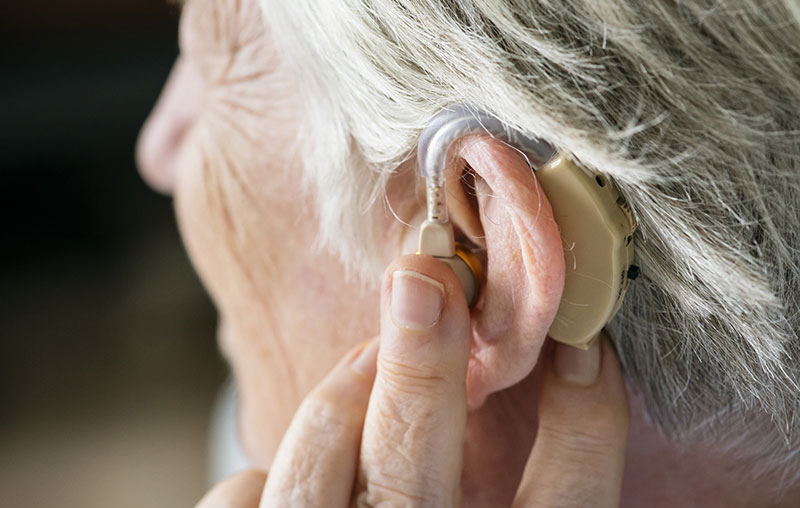As COVID-19 has continued to spread throughout the United States, more and more businesses are requiring patrons to wear face masks at all times while on their premises. We believe in the efficacy of face masks, but we also recognize how they interfere with most common hearing aid models, making it more difficult for the hard-of-hearing (HOH) to communicate with others.
Add to this the concern that hearing aid efficacy is perhaps more important now than ever before, when face masks are covering mouths and eliminating the possibility of lipreading - a common adaptation made by the hard of hearing to improve communication.
What steps can you take to comply with face mask mandates, protect yourself from contracting COVID-19, and still communicate effectively with friends, family, caregivers, and service providers?
Wearing a mask with hearing aids
Aside from making it more difficult to read lips, masks also make it more difficult to wear hearing aids. It's easy for the loops on a mask to get caught on the wire of a behind-the-ear hearing aid, either dislodging it or removing it completely. This increases the risk of losing an expensive hearing aid and makes continuous adjusting and correcting necessary.
Additionally, masks can affect the placement of the hearing aid, putting pressure on the wire or the body of the hearing aid, causing it to shift within the ear and limiting efficacy.
Finding solutions for the problem
Choose a mask that ties instead of a loop mask
One option is to choose a mask that ties rather than a mask that loops around your ears. When purchasing your mask, be sure to read the description: masks that tie are often referred to as surgical masks or tie masks, while masks that loop around the ear - and interfere with hearing aids - are referred to as loop masks. Avoid purchasing loop masks if at all possible.
When tying a tie mask or surgical mask, first place the top of the mask over the bridge of your nose. Grab the top ties and lift them high on the crown of your head. Tie them in a bow. Then, grab the lower ties. Reach behind your neck and tie them loosely there. These masks typically don't come in contact with your ears at all - the ties go above and below the ears - which means that they are less likely to interfere with the functionality of your hearing aides.
Use a mask extender
Loop masks are the most common style sold in stores and given out at clinics, pharmacies, and other businesses, which means many people with hearing aids might only have access to loop masks. Homemade or store-bought mask extenders can pull the loops away from the back of your ears and away from your hearing aids to prevent interference.
This list from health.com can help you find a mask extender that works for you.
As a side note: those who wear hearing aids should be especially careful to ensure their hearing aids don't fall out (or go flying across the room!) when they take off their glasses or mask.
Other tips and suggestions
If you're hard of hearing, let whoever you're communicating with know right away that you have difficulty hearing so they can speak up. If they have a complicated message, like a medication change or a new treatment plan, ask them to write it down to be sure you understand. Move to a quieter place to talk if possible.
Communicating effectively during COVID-19
If you have a loved one who is hard of hearing, communication can be challenging even in ideal circumstances. Communicating during the COVID-19 pandemic has become more challenging than ever before as new barriers have emerged:
- masks can muffle sound, making it more difficult to project and enunciate
- masks cover your mouth, making lipreading impossible
- masks can interfere with hearing aid fit, making them less effective in amplification
- social distancing increases the space between you, and therefore the distance sound has to travel, making it more difficult to hear
For these reasons, adjusting the way we communicate with those we love who have hearing limitations is crucial for effective exchange. The team at Vista Springs hopes you find these tips helpful.
Go to quiet place
Extraneous noise makes hearing even harder. Move to a quieter place before you attempt to communicate, and then ask how they prefer to communicate. Be sure to speak loudly and enunciate your words.
Choose a transparent mask
Some organizations and universities have stepped up to present solutions for lipreaders. A few of the options out there include:
- The ClearMask
- Face Mask with Clear Window on Amazon
- Transparent Mask on Etsy
These masks are not yet widely available, so you'll have to plan ahead, shop around, and purchase a transparent mask prior to your visit. Alternatively, you can make a deaf-friendly mask following these instructions if you're able to find the supplies you need.
Write it down
Having a pen and a piece of paper handy can go a long way in clarifying what you're trying to say when lipreading is impossible and hearing is difficult. Don't be afraid to write something down if you've repeated it once without success. The sooner your loved one is able to connect the dots and receive the message, the less likely both of you are to become frustrated and throw in the towel.
Use body language
Using body language or gestures to get a message across can be helpful for those who are hard of hearing. You can point at things you're talking about, use the thumbs up or thumbs down signals, or gesture to provide clarity.





